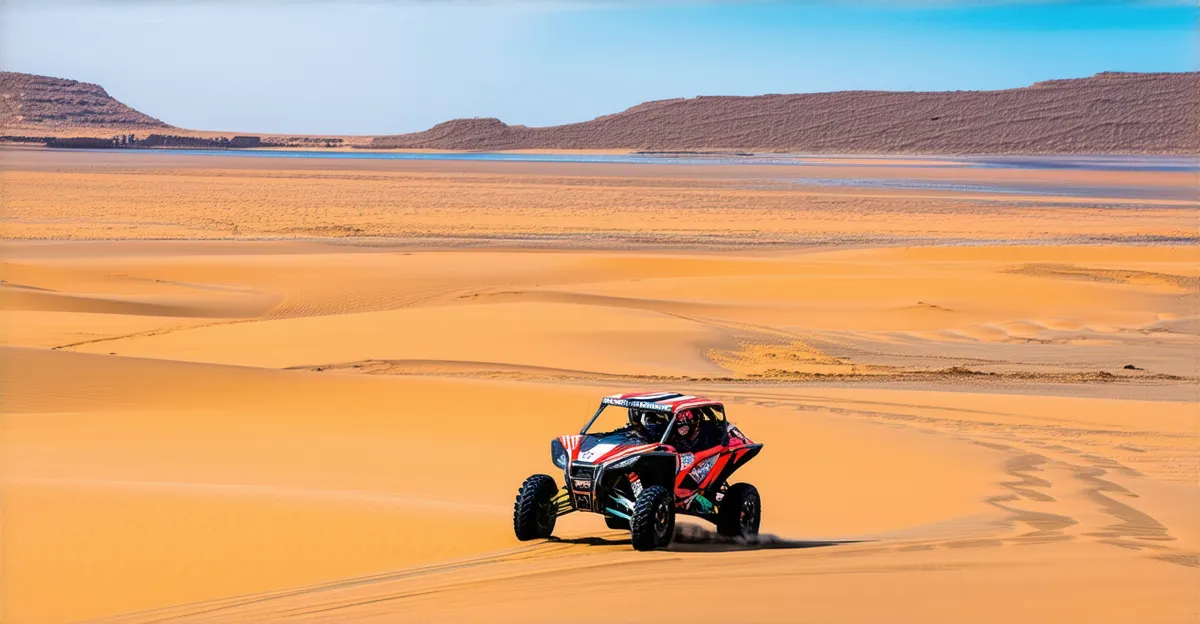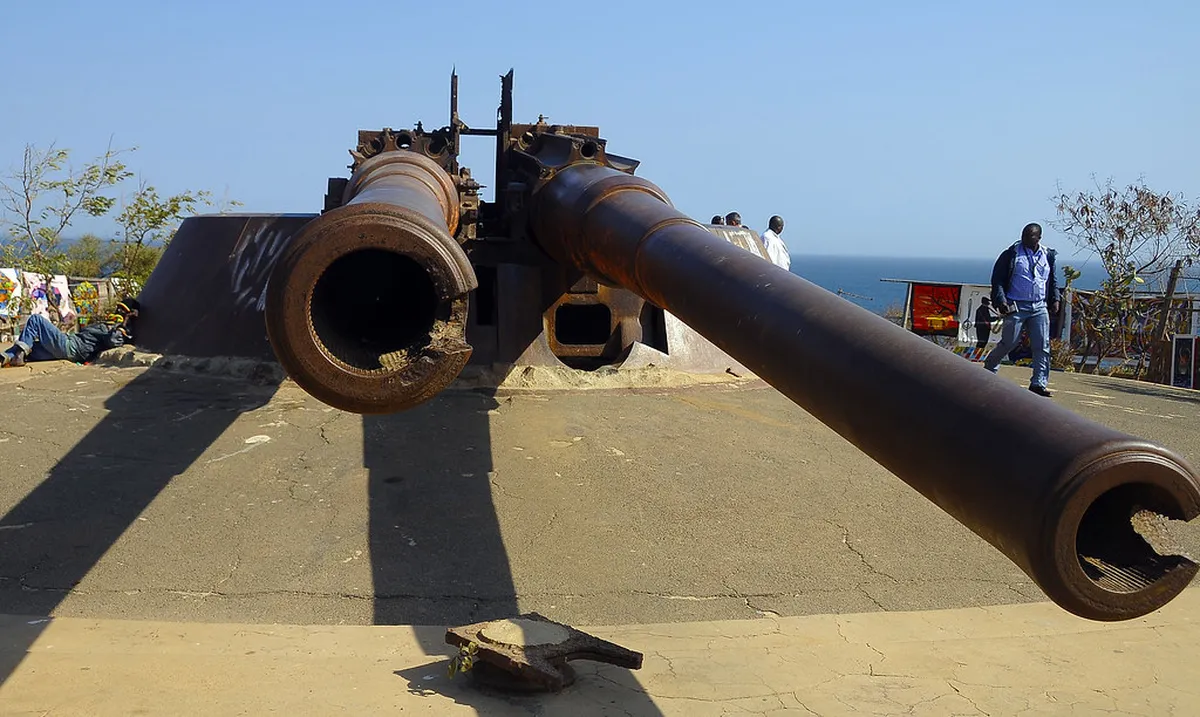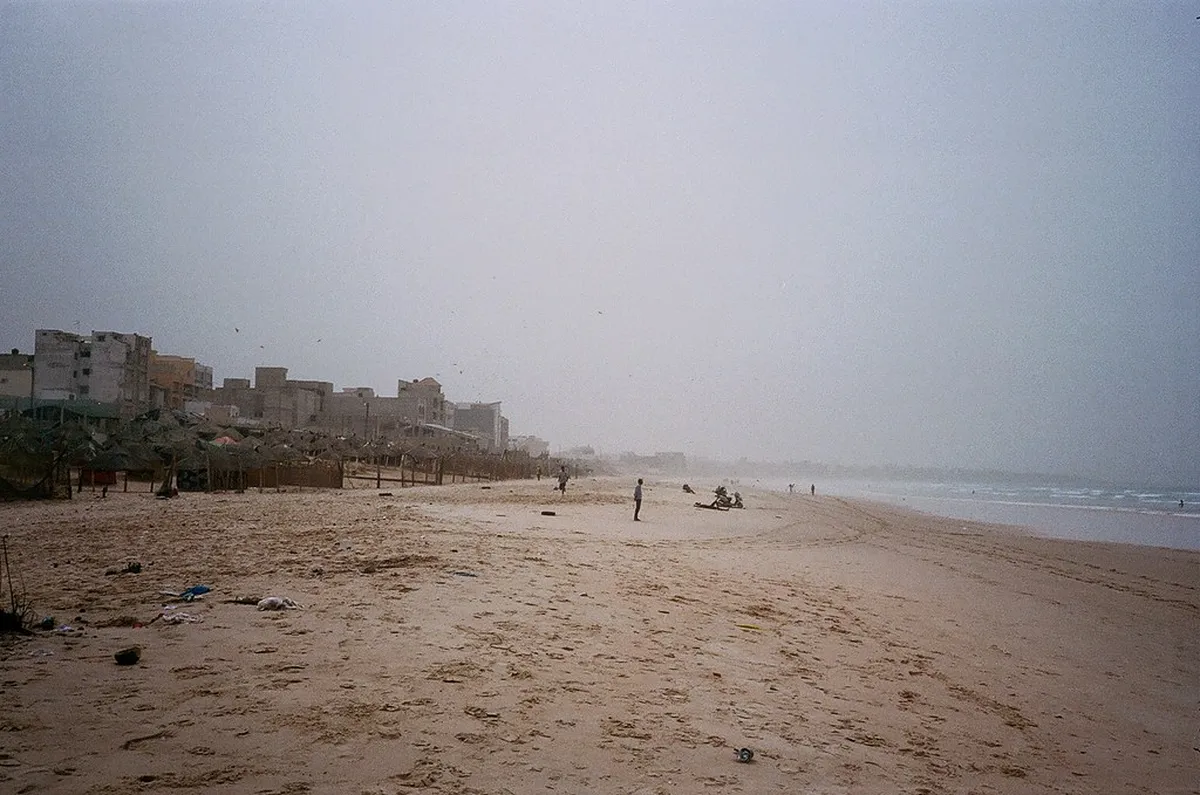
Dakar Itinerary: Unforgettable 5-Day Adventure
Table of Contents
Dakar Itinerary: Your Ultimate 5-Day Guide
Dakar, the vibrant capital of Senegal, is renowned for its rich cultural heritage, lively music scene, and stunning coastal landscapes. This Dakar itinerary allows you to experience the city’s fascinating blend of modernity and tradition. From historic landmarks like the African Renaissance Monument to the bustling markets of Sandaga, and the serene beauty of Gorée Island, this guide ensures you don’t miss the must-visit attractions and local Experiences that will make your trip truly memorable.
Want to find the best travel deals for this destination? plan your adventure with our adventure planning specialist!
Key Takeaways
- Day 1: Visit the African Renaissance Monument, Museum of Black Civilizations, and stroll through the lively streets of Plateau.
- Day 2: Take a ferry to Gorée Island, explore the House of Slaves, and enjoy the stunning views from the island’s cliffs.
- Day 3: Visit the Sandaga Market for vibrant local produce, sample traditional dishes at local eateries, and explore the sights of Medina.
- Day 4: Discover the unique landscape of Lake Retba (Pink Lake), take a guided tour, and try out sandboarding or quad biking.
- Day 5: Spend a leisurely day at Yoff Beach or Ngor Island, enjoy surfing, and indulge in fresh seafood at beachside restaurants.
Day 1: Discover the Cultural Heart of Dakar
On your first day in Dakar, immerse yourself in the vibrant essence of this fascinating city. Begin your adventure by visiting the African Renaissance Monument, a magnificent tribute to African independence and ingenuity. This iconic structure, standing at 49 meters tall, offers not just a historical insight but also panoramic views of the city that are best enjoyed from its viewing platform. Don’t forget your camera!
After soaking in the sights from the monument, head over to the Museum of Black Civilizations. This museum showcases the rich cultural heritage and history of African civilizations, featuring a variety of exhibits that celebrate art, history, and the accomplishments of the African diaspora. The modern architecture of the museum itself is a sight to behold, representing a blend of traditional and contemporary styles.
Pro Tip: Allocate at least two hours for the museum to fully appreciate its vast collection.
As you leave the museum, take a leisurely stroll through the lively streets of Plateau. The area is bustling with locals, vibrant shops, and street vendors offering everything from handcrafted souvenirs to delicious Senegalese street food. Be sure to taste some thieboudienne, a local dish made with rice and fish, quintessential to Senegalese cuisine.
| Time | Activity | Location |
|---|---|---|
| 9:00 AM | Visit African Renaissance Monument | Avenue Moussa Tavele |
| 11:00 AM | Explore Museum of Black Civilizations | Place de l’Obélisque |
| 1:00 PM | Lunch at local eatery | Plateau |
| 3:00 PM | Stroll through Plateau streets | Downtown Dakar |
Continue your exploration by visiting the local art galleries. Dakar is known for its vibrant arts scene, showcasing both contemporary and traditional African art. Take time to appreciate the stunning pieces and perhaps engage with local artists to learn more about their inspirations and techniques.
As evening approaches, enjoy a sunset walk along the coast at Les Almadies. This area, known for its beautiful cliffs and ocean views, is an ideal spot to reflect on your first day while witnessing the breathtaking hues of the sunset over the Atlantic Ocean. There are numerous restaurants in the area where you can savor delicious seafood dishes, providing the perfect ending to your day.
Key Highlights of Day 1:
- African Renaissance Monument – A landmark of independence.
- Museum of Black Civilizations – A must-visit for cultural enthusiasts.
- Exploration of Plateau – A vibrant area filled with life.
- Sunset at Les Almadies – Unmatched coastal views.
In conclusion, Day 1 of your Dakar itinerary offers a blend of history, Culture, and natural beauty. Prepare to uncover the hidden gems of this lively city as you embark on your Senegalese adventure.
Day 2: Explore the Historic Gorée Island
Your second day in Dakar promises to be both enriching and moving as you explore Gorée Island, a UNESCO World heritage site and a significant historical landmark. It is renowned for its deep cultural roots and poignant history tied to the transatlantic slave trade.
Morning: Ferry Ride to Gorée Island
Start your day early by taking a ferry ride from Dakar’s ferry terminal to Gorée Island. The ferry ride is not only a means of transportation but also offers stunning views of Dakar’s waterfront, where the vibrant city meets the expansive Atlantic Ocean. Plan to leave around 8 AM to make the most of your day on the island.
Insider Tip: Ensure you have your ferry tickets purchased ahead of time, especially during peak tourism season, to avoid long queues.
Mid-Morning: Visit the House of Slaves

Upon arrival, head straight to the House of Slaves (Maison des Esclaves), the most iconic symbol of Gorée Island’s tragic history. This museum educates visitors about the harrowing Experiences of enslaved Africans. You’ll be able to view the infamous “Door of No Return,” through which countless individuals were forced to leave Africa forever.
As you walk through the rooms and panels detailing the slave trade’s impact, take a moment to reflect on the stories shared and the resilience of those who lived through this dark chapter of history.
Lunch: Enjoy Local Cuisine
After your profound visit, head to one of the island’s local restaurants to sample traditional Senegalese cuisine. Try the local favorite, thieboudienne, a delicious dish made of fish, rice, and vegetables, all cooked together for a flavorful experience. Enjoying your meal on a terrace with beautiful ocean views adds charm to the whole experience.
Afternoon: Discover the Island’s Views and Culture
Post-lunch, take some time to wander around Gorée Island. The narrow cobblestone streets are lined with colorful colonial buildings, art galleries, and artisan shops that reflect the island’s rich Culture. Make sure to visit the Fortification of Gorée, offering breathtaking panoramic views of the sea and Dakar. The fort dates back to the 18th century and gives insight into the island’s past as a trading post.
Tip: Bring your camera, as the picturesque views and vibrant architecture provide excellent photo opportunities.
Late Afternoon: Return to Dakar

As the sun starts to set, you can catch a ferry back to Dakar. The return trip can be a perfect way to reflect on your visit to this poignant site. Perhaps take a moment to appreciate the beauty of the coast against the backdrop of a setting sun, a reminder of the resilience and hope that characterizes the spirit of Gorée Island.
Evening: Dinner and Reflect
Back in Dakar, consider dining at a local restaurant where you can share your Experiences from the day. Engaging with local people and fellow travelers can enrich your understanding of the island’s significance.
Gorée Island may only occupy a day in your Dakar itinerary, but its impact will resonate in your heart long after you leave.
“Gorée Island remains a powerful symbol of strength and endurance, representing both the beauty and the tragedy of human experience.” – Travel Quote
Day 3: Immerse in Local Markets and Cuisine
On Day 3 of your Dakar itinerary, prepare yourself to dive deep into the vibrant heart of Senegalese culture through its local markets and exquisite cuisine. This day is all about engaging with the rich tapestry of flavors and traditional practices that define Dakar’s culinary scene.
10am: Start at Sandaga Market
Your culinary adventure kicks off at the Sandaga Market, one of the most famous markets in Dakar. The market buzzes with energy, providing an immersive experience filled with vibrant colors and aromatic spices. As you wander through the aisles lined with fresh fruits, vegetables, fish, and local products, take the time to indulge your senses.
Pro Tip: Want to get the best deals? Bargaining is a common practice here, so don’t hesitate to negotiate prices with the vendors.
11:30am: Explore the Medina Neighborhood
After experiencing the hustle of Sandaga, take a short walk to the Medina neighborhood. Known for its narrow streets and bustling atmosphere, Medina is an excellent place to witness daily life in Dakar. Here, you will find local eateries offering delicious, traditional dishes such as thieboudienne (fish and rice) and yassa poulet (chicken marinated in lemon and onions).
Make sure to stop by a local vendor for the pastels, a savory snack filled with fish or meat, perfect for a midday treat.
1pm: Lunch at a Local Eatery
For lunch, choose one of the many eateries in Medina or nearby. Chez Fatou, known for its authentic Senegalese dishes, is a great option. Sit among locals as you enjoy a hearty portion of thieboudienne, which is often considered Senegal’s national dish. Pair it with a refreshing glass of bissap, a local hibiscus drink, to complete your meal.
3pm: Cooking Class Experience
After lunch, take your culinary journey a step further by signing up for a cooking class. This experience allows you to learn how to prepare Senegalese dishes using traditional methods and local ingredients. Engaging with a local chef offers insight into the importance of Senegalese food in cultural celebrations and everyday life.
| Dish | Ingredients | Cooking Method |
|---|---|---|
| Thieboudienne | Fish, rice, vegetables, tomato sauce | Steamed and sautéed |
| Yassa Poulet | Chicken, lemon, onions, mustard | Marinated and grilled |
| Pastels | Pastry, fish/meat filling | Deep-fried |
6pm: Evening Stroll Along the Corniche
Conclude your day by taking a leisurely stroll along the Corniche, a scenic coastal road offering stunning views of the Atlantic Ocean. It’s a perfect moment to reflect on your experiences while soaking up the vibrant atmosphere of Dakar.
As the sun sets, consider stopping at one of the seaside restaurants for dinner, where you can savor fresh seafood while enjoying the beautiful ocean view.
Key Highlights:
- Sandaga Market for fresh produce and local goods
- Traditional Senegalese dishes at local eateries
- Engaging cooking class to learn about Senegalese culinary arts
- Scenic evening walk along the Corniche
Day 3 is designed to immerse you in the local culture, offering a unique perspective of Dakar through its delectable cuisine and lively markets. It’s an essential part of your Dakar itinerary that should not be missed!
Day 4: Adventure at the Pink Lake and Surroundings
Prepare for an exhilarating day of exploration as you discover the stunning Pink Lake, known locally as Lake Retba. This unique lake is famous for its striking pink hue, which is caused by the high concentration of salt and the presence of a particular type of algae. The vibrant colors change throughout the day, making it a photographer’s paradise.
Morning: Journey to the Pink Lake
Start your day early with a hearty breakfast before heading out to Lake Retba, located approximately 30 kilometers (about 19 miles) from Dakar. It is easily accessible by taxi or organized tours. The route to the lake offers picturesque views of Senegalese countryside, providing insight into the local landscape and culture.
“The beauty of Lake Retba is something you can only appreciate in person. The colors, the scenery… it takes your breath away!” – Local Tour Guide
Mid-Morning: Explore the Unique Landscape
Upon arriving at the lake, take a moment to soak in the breathtaking surroundings. The pink waters contrast dramatically with the white salt flats along the shore. Consider hiring a local guide who can share valuable insights into the history and ecology of the lake.
| Activity | Description | Time Frame |
|---|---|---|
| Guided Tour | Explore the salt harvesting process and learn about the local community. | 1-2 hours |
| Sandboarding | A thrilling ride down the sand dunes by the lake. | 1 hour |
| Quad Biking | Experience an adrenaline rush while navigating the rugged terrain. | 30 minutes |
Afternoon: Adventure Activities
After soaking in the views and learning about the lake’s significance, it’s time for some adventure! You can choose to try sandboarding on the surrounding dunes for an exhilarating experience or rent a quad bike to traverse the sandy landscape. These Activities not only provide a rush of fun but also allow you to connect with the stunning natural environment around the lake.
Lunch: Savor Local Flavors
Post-Adventures, indulge in a leisurely lunch at one of the local eateries. Here, you can sample fresh seafood dishes that Senegal is famous for, such as thieboudienne, a delicious fish and rice dish that embodies the local culinary culture. Enjoying your meal with a view of the lake will undoubtedly elevate the experience.
Evening: Return to Dakar
As your day at Lake Retba concludes, make your way back to Dakar. Reflect on the unique beauty and experiences of the day. The scenic drive back to the city offers another opportunity to appreciate Senegal’s enchanting landscapes.
“Every visit to the Pink Lake is different; the light, the colors, and the laughter of the local people make it special.” – Traveler Review
With adventurous memories in tow, you will be rejuvenated and ready for more exciting discoveries in your Dakar itinerary.
Day 5: Relax at Dakar’s Beautiful Beaches
The final day of your Dakar itinerary is dedicated to unwinding at the stunning beaches surrounding the city. Dakar boasts some of the most picturesque beaches in West Africa, each offering a unique atmosphere and Activities that cater to diverse tastes.
Morning: Yoff Beach

Start your morning at Yoff Beach, known for its vibrant atmosphere and stunning coastal views. The beach stretches for kilometers, making it a perfect spot for early morning walks or a refreshing jog along the shore. Take in the sight of colorful fishing boats returning from their night catches.
Pro Tip: Arrive early to enjoy a moment of tranquility before the beach fills up with locals and tourists alike. It’s also a great time to witness fishermen hauling in their nets, which can be a colorful and engaging sight.
Midday: Ngor Island Excursion
After a leisurely morning, consider taking a short ferry ride to Ngor Island. This small island is renowned for its crystal-clear waters and laid-back vibe. The ferry ride allows you to appreciate the coastal beauty of Dakar from a different perspective.
Once on the island, you can relax on one of its secluded beaches or partake in exciting activities such as surfing or snorkeling in the calm waters. Ngor Beach offers rental services for surfboards if you’re up for a bit of adventure.
Afternoon: Beachside Relaxation and Dining
For lunch, savor delectable fresh seafood at one of the numerous beachfront restaurants. Many of these establishments feature outdoor seating that allows you to dine while enjoying the warm ocean breeze and stunning views.
| Restaurant | Specialty Dish | Average Price |
|---|---|---|
| Le Ngor | Grilled Lobster | $15 |
| Chez Momo | Seafood Platter | $20 |
| Les Fous de la Mer | Fish Tagine | $10 |
Each of these restaurants not only serves delicious meals but also provides a lovely ambiance perfect for relaxing after a long day.
Evening: Sunset and Final Reflections
As the sun begins to set, claim a spot on the beach to witness the spectacular sunset over the Atlantic Ocean. The vibrant hues of orange and pink reflecting on the water create a perfect backdrop for your last evening in Dakar.
Take a moment to reflect on your unforgettable Dakar itinerary. From the rich culture and history to breathtaking landscapes and tasty cuisine, Dakar holds a special charm that lingers long after you leave.
Final Tip: Don’t forget to snap some pictures of the sunset and beach for your travel album. These memories will remind you of the inspiring beauty of Dakar.
By the end of this day, you’ll have experienced the best of what Dakar’s beaches offer, making your travel journey truly memorable.
Best Time to Visit: Seasonal Insights for Your Dakar Itinerary
When planning your Dakar itinerary, understanding the best time to visit is crucial for optimizing your experience. Dakar, situated on the Cap-Vert Peninsula, enjoys a hot semi-arid climate influenced by its coastal location. As a result, the ideal time to explore the city can vary depending on your activities and personal preferences.
Winter (November to February) is often regarded as the best season to visit Dakar. During these months, the temperatures are milder, typically hovering around 20°C to 30°C (68°F to 86°F). The weather is dry and sunny, making it perfect for outdoor activities such as exploring cultural sites, visiting beaches, and indulging in local cuisine. Tourist spots, including the African Renaissance Monument and the bustling streets of Plateau, are more enjoyable without the overwhelming heat.
Furthermore, this period corresponds with the world-renowned Tam-Tam des Bambous Festival, which celebrates traditional dance, music, and culture, allowing travelers to immerse themselves in Senegalese heritage.
Spring (March to May)
Spring in Dakar marks the transition towards warmer weather. Temperatures begin to rise, reaching up to 32°C (about 90°F) in April and May. This season also sees the Harmattan Winds, which blow in from the Sahara, causing dry air and cooler night temperatures. In March, the city hosts various cultural activities such as the Dakar Biennale, showcasing contemporary African art. Visitors can enjoy local arts while experiencing the vibrant atmosphere. However, be prepared for higher humidity levels as the rainy season nears.
Summer (June to August)
Summer is characterized by hotter temperatures, often exceeding 35°C (95°F). This period also marks the onset of rainy season, especially in August, which can disrupt outdoor activities. Although the beaches remain popular, you might want to take advantage of the early morning or late afternoon sun to prevent heat exhaustion while visiting sights like the House of Slaves on Gorée Island.
However, if you decide to visit during these months, expect fewer tourists and lower prices on accommodation, which could be beneficial if you’re traveling on a budget. Just remember to stay hydrated and seek shade when needed.
Fall (September to October)
Fall is typically a transitional period experiencing residual warmer temperatures and less rainfall. October can be particularly pleasant for exploring rich local markets like Sandaga Market and indulging in street food. Cooler evenings make it suitable for enjoying vibrant Nightlife and social events in Dakar. Festivals such as the Festival International de Jazz de Dakar take place during these months, offering great entertainment options for music enthusiasts.
In summary, while Dakar can be visited throughout the year, November to February is the most favorable time due to cooler temperatures and lively local Events. However, each season brings its unique experiences to the Dakar itinerary, allowing rich cultural, culinary, and outdoor Adventures regardless of when you decide to visit.
Travel Tips for Your Dakar Itinerary: Safety, Transport, and Costs
Planning your Dakar itinerary requires some forethought, particularly when it comes to safety, transport, and costs. As one of the most vibrant capitals in West Africa, Dakar is an enticing destination, but understanding the local environment is essential for a smooth travel experience.
Safety Tips While Exploring Dakar
Safety should always be your top priority. Here are some essential tips to ensure a secure visit:
- Stay Alert: Always keep an eye on your surroundings. Busy areas can attract petty crime, such as pickpocketing.
- Use Reliable Transport: Opt for reputable taxi services or ridesharing apps instead of flagging down taxis in the streets.
- Avoid Walking Alone at Night: While areas like the Plateau may seem bustling in the evening, it’s wise to avoid walking alone, especially in less frequented spots.
“Your safety is your responsibility; trust your instincts and stay informed.”
Getting Around Dakar
Understanding local transport options will enhance your Dakar itinerary:
- Taxis: Taxis are readily available and convenient. Always agree on a fare before beginning your journey as many do not have meters.
- Public Buses: The Dakar Dem Dikk buses are an affordable way to navigate the city. However, they can be crowded and are less reliable.
- Car Rentals: Renting a car offers freedom, but be prepared for local driving conditions and traffic that can be chaotic.
Budgeting for Your Stay
When creating a budget for your trip, consider the following aspects:
| Expense Type | Estimated Cost (USD) |
|---|---|
| Accommodation (per night) | $30 – $150 |
| meals (per day) | $15 – $50 |
| Transport (daily rate) | $5 – $20 |
| attractions (entrance fees) | $2 – $10 |
Using this table as a guide will help you get a clearer picture of the potential costs involved in your Dakar itinerary. Additionally, always carry some cash, as smaller establishments might not accept credit cards.
Final Thoughts on Your Dakar Itinerary
In summary, there are crucial aspects to keep in mind when planning your travel to Dakar. Stay aware of your surroundings, choose transport wisely, and budget accordingly to make the most of your trip. With these tips in hand, you can explore the dynamic culture and beauty of Dakar with confidence.
This 5-day Dakar itinerary is designed to immerse you in the rich culture, history, and beauty of Senegal’s capital. From iconic Landmarks to hidden gems, Dakar offers a plethora of experiences to suit every traveler. Adapt this guide to fit your interests, and start planning your Dakar adventure today to create unforgettable memories!
Frequently Asked Questions
Insider Tip: Get the most out of your Dakar visit with guided tours!
A: The best time to visit Dakar is from November to May, when the weather is pleasant and festivals take place.
A: A 5-day itinerary allows you to explore the major attractions and enjoy local culture.
A: The African Renaissance Monument, Gorée Island, and local markets are top attractions.
A: Dakar offers taxis, car rentals, and buses, but negotiating prices is common.
A: You might consider a visit to the Ngor Island or the historic city of Saint-Louis.
A: Check out local music venues, street food stalls, and cultural festivals for true Senegalese experiences.